LaX3 Scintillator Research
Introduction
Future planetary missions such as BepiColombo and Solar Orbiter are extremely resource limited in both mass and power. Due to the vicinity of the spacecraft to the Sun, the onboard instrumentation will face harsh environments as far as radiation levels and thermal loads are concerned. Only radiation-hard detectors that need little or no cooling will be able to successfully operate after long cruise times and during the expected mission lifetimes. Until the present time the energy resolution of scintillators was considered too poor to satisfy the geochemistry resolution requirements for remote-sensing gamma-ray spectrometers – meaning, their ability to uniquely separate the elemental gamma-ray lines emanating from the surface regolith. The recently discovered lanthanum halide (LaX3:Ce) scintillators will revolutionize spectroscopic systems because of their excellent energy resolutions and proportionality of response when compared with traditional scintillating materials. LaBr3:Ce5% has a fast light output decay (16 ns) and an emission spectrum with a peak at 380 nm. The light yield is typically 60 000 photons per MeV or 165% relative to a standard NaI(Tl) scintillator. The material density is 5.07 g cm-3. FWHM energy resolutions of 3% at 662 keV (137Cs) and 2.0% at 1332 keV (60Co) have been reported for smaller volume crystals (5.3 cm3 and 12.5 cm3).
The Future Missions Preparation Office in collaboration with Saint Gobain Crystals and Detectors, the Technical University of Delft, and Cosine Research BV, began an ambitious research and development programme to advance crystal growth technology to produce large volume LaX3 detectors. The stated goal of this programme was to produce large LaBr3 volume scintillation crystals to be used as part of the Mercury Gamma-ray and Neutron Spectrometer (MGNS) on BepiColombo. Specifically, the gamma-ray detector has to be:
- a 3 × 3 inch right circular cylinder crystals with no cracks or imperfections
- have an energy resolution at 662 keV of ≤ 3% FWHM
- radiation hard to a total fluence of 1 Mrad equivalent into Si
Because of requirement 2, most of the work has concentrated on LaBr3. As of December 2006, the goals listed above have been met.
At the start of the programme, there were four overriding questions:
- could crystals be grown to the correct size without cracking?
- would the energy resolution degrade with increasing volume?
- would radiation degrade the scintillation mechanism resulting in worse energy resolution?
- after a major solar particle event would the material activate so badly as to be unusable?
Each of these questions are explored in the next four articles where study results are also presented.
Issue 1 - Growth
The compound is relatively easy to produce, since it melts congruently at 860 °C and therefore can be grown by a number of melt based techniques, such as Bridgeman or Czochralski. However, the production of crystals with volumes above ~ 50 cm3 has been plagued by growth problems, largely related to cracking. This arises because the lanthanum halides are highly anisotropic materials with hexagonal structures. As such, the thermal conductivities and thermal expansion coefficients differ for the main crystallographic axes. This leads to the introduction of very high stresses into the lattice during the cooling process leading to fracture and cracking. The photo below illustrates the problem.
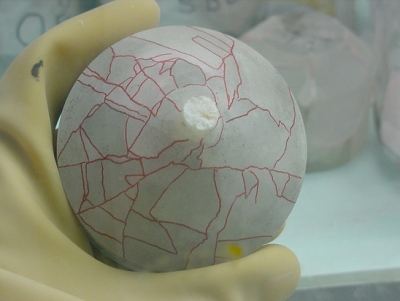 |
|
After one year of research and development, the cracking problem has been "cracked". Credit: ESA |
Issue 2 - Scaling of the energy resolution with detector volume
The table below shows the evolution of the energy resolution with crystal size during the course of the programme. As can be seen, the energy resolution has actually improved with increasing crystal volume. However, this is almost certainly due to improvements in quality control as the programme has evolved.
| LaBr3 crystal growth evolution | |||
| Crystal size Diameter × height cm2 |
Volume cm3 | Volume increase factor |
ΔE/E at 663 keV percent |
| 0.3×0.3×1.0 | 0.90 | 1 | 3.2 |
| 1.3×1.3 | 1.73 | 1.9 | 3.4 |
| 1.9×1.9 | 5.39 | 6 | 3.4 |
| 2.5×2.5 | 12.27 | 14 | 2.8 |
| 3.8×3.8 | 43.10 | 48 | 2.8 |
| 5.1×5.1 | 103.0 | 114 | 3.0 |
| 5.1×7.6 | 155.2 | 172 | 3.0 |
| 7.6×7.6 | 347.5 | 386 | 2.8 |
| 10.2×7.6 | 462.7 | 514 | 3.0 |
Issue 3 - Radiation hardness
The radiation hardness of lanthanum halide scintillators has been investigated at the Kernfysisch Versneller Instituut in Groningen, the Netherlands. This facility operates a 200 MeV superconducting cyclotron which can produce precisely tunable proton and ion beams across the energy range ~ 20 MeV/ nucleon to 200 MeV/ nucleon. The radiation assessment was carried out using a series of controlled irradiations on a set of five LaBr3:Ce scintillators. The crystals were one inch right circular cylinders packaged in aluminium housings and viewed through optical windows. Four crystals were exposed to simulated solar proton events over the energy range 60 MeV to 200 MeV having a spectral shape approximating that of the August 1972 solar particle event. Each crystal was exposed to a different total fluence. One crystal was exposed to an integral fluence of 109 protons cm-2, a second to 1010 protons cm-2, the third to 1011 protons cm-2 and the fourth to 1012 protons cm-2. The latter corresponds to an absorbed dose in silicon of 1 Mrad or in SI units, 10 kGy. The fifth crystal was un-irradiated and served as a reference. The crystals were characterized both before and after the irradiations in terms of energy resolution, light output and background count rate. The key conclusions of the study are that LaBr3 is radiation tolerant showing no measurable degradation effects when exposed to experimentally simulated Solar proton flare spectra with fluences up to 1012 protons cm-2 (~1 Mrad or 10 kGy absorbed dose in silicon) and integrated above a 60 MeV energy threshold.
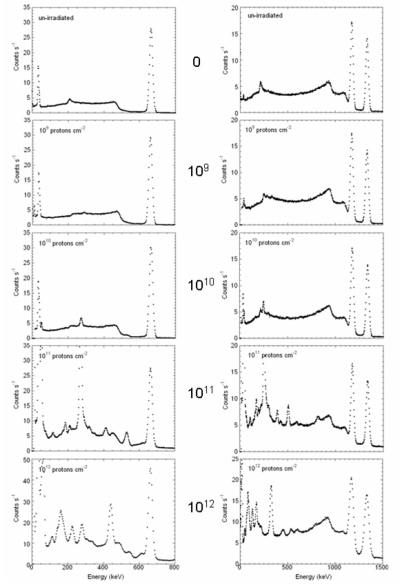 |
The above graphs are a compilation of 137Cs and 60Co spectra taken 5 days after each irradiation. The irradiating fluences in units of protons cm-2 are given between the two columns of spectra. Note the y-axis is the same for the first four spectra and the only obvious effect of the irradiations is the growth of activation lines at the highest fluences. The energy resolution stayed constant at 3% FWHM at 662 keV.
Issue 4 - Activation
After the irradiations, the count rates due to activation were monitored as a function of time. Because of the large activation of the crystal exposed to 1012 protons cm-2, it could not be handled for several weeks. Initially, after the irradiation the registered activity was 2 mSv/hr. After 15 days the activity fell to 0.2 mSv/hr. It was noted ~ 1 day after a hypothetical 1012 protons cm-2 flare, 90% of events due to activation occur at energies less 1100 keV, whereas 16 days later the same fraction of events occur at energies < 700 keV indicating a softening of the spectrum. In both cases, there were virtually no events above 2 MeV.
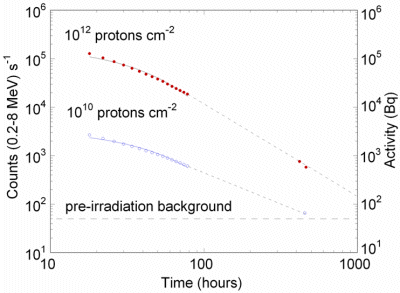 |
|
Figure 1. Decay profiles for the 1010 protons cm-2 and 1012 protons cm-2 data. The count rates are integrated over the energy range 0.2 to 8 MeV. The dashed lines show power-law extrapolations to the data. For comparison, we also show the pre-irradiation background level. |
Figure 1 shows the decay curves for the 1010 protons cm-2 and 1012 protons cm-2 irradiated samples. The count rates represent the integral counts over the energy range 200 keV to 8 MeV. Using power law extrapolations for both data sets we estimate that the background will return to within a factor of two of its original pre-irradiation value within ~12 and 50 days, when irradiated at 1010 protons cm-2 and 1012 protons cm-2, respectively. Bear in mind however, that 90% of this increased background occurs at energies < 700 keV.
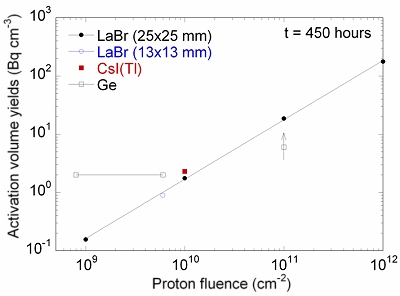 |
|
Figure 2. The volume yields due to activation (the number of counts in the 0 to 3 MeV energy range that can be attributed to the activation of the samples in Bq per cubic cm. The yields are given for different irradiation fluences and materials. Note the intrinsic activities of the crystals have been subtracted - so the measured yields are strictly due to the activation of the sample due to the incident fluence. The data were all taken 450 hours after irradiation. Note, the Ge data point at 6 × 1010 protons cm-2 is a lower limit since the efficiency of the detector had been seriously reduced by radiation damage. |
Figure 2 shows the measured count rates in the energy region 0-3 MeV as a function of irradiated fluence, measured by all four crystals 17 days after the irradiations (450 hours). The count rates are given in the form of activation volume yields (meaning, the number of counts in the 0 to 3 MeV energy range that can be attributed to the activation of the samples in units of Bq per cubic cm - in essence we take the count rate at time t after the irradiation, subtract the pre-irradiation background and divide by the crystal volume). The activation volume yield is a useful quantity when comparing the activation susceptibility of different materials of similar size. As an example, at 1010 protons cm-2 we plot the derived yields for a CsI(Tl) crystal and a germanium crystal exposed to the same fluence and measured at the same time after being irradiated. In fact, LaBr3 behaves as a generic intermediate-mass material showing the same activation yields as CsI(Tl) and Ge above 1010 protons cm-2 and significantly less than Ge below this fluence. Note, the Ge data point at 6 × 1010 protons cm-2 is a lower limit because the damage induced by this fluence was found to have radically reduced the efficiency of the detector.
A comprehensive activation analysis of the gamma-ray emissions from one of the crystal samples was carried out using a lead-castle equipped with a large volume (198 cm3) Ge detector. The sample had been irradiated with a fluence of 1011 protons cm-2. The spectrum measured 50 hours after the irradiation revealed the presence of ~ 120 discrete lines across the energy range 30 keV to 3 MeV of which about a half have been identified and of these about 40% can be attributed to La or Br.
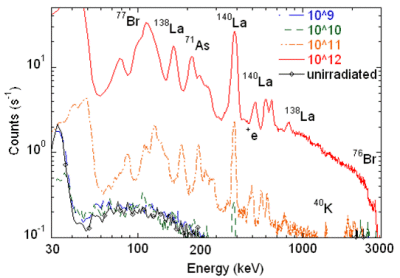 |
|
Figure 3. Compilation of irradiated spectra acquired ~ 17 days after the irradiations, along with a tentative identification of activation line features. For comparison we also show the un-irradiated spectrum. Note, we have not subtracted the intrinsic background of the crystals - hence the pre-irradiated, 109 p cm-2 and 1010 p cm-2 spectra are similar since the intrinsic background is much greater than the induced count rate due to activation in these samples. |
Lastly, we have investigated how activation lines manifest themselves when operating a LaBr3 crystal as a spectrometer. A comparison of irradiated spectra acquired 17 days after the irradiations show that that significant activation features only appear for irradiating fluences ≥ 1011 cm-2 (see figure 3).
